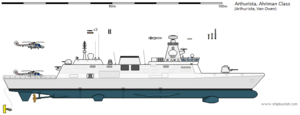Ahriman-class frigate

| |
| Class overview | |
|---|---|
| Name: | Ahriman-class frigate |
| Builders: | Arthuristan Dynamics |
| Operators: |
list error: <br /> list (help) Commonwealth Navy Lion's Rock Navy |
| Preceded by: | Type-24 frigate |
| General characteristics | |
| Type: | Frigate |
| Displacement: | 3,600 tonnes |
| Length: | 121m |
| Beam: | 16.34m |
| Draught: | 5.95m |
| Propulsion: | 2-shaft CODOG system, 2 x Apollo Motors Super Wayfarer diesel engines (4,500 shp each), 1x Rollers Engineering Olympus TM3 (21,000 kW) |
| Speed: | 28kn |
| Range: | 15,000 kilometres (16 knots) |
| Troops: | Up to 96 marines |
| Complement: | 114 |
| Sensors and processing systems: |
|
| Armament: |
|
| Armour: | steel shrapnel sheets, kevlar spall liners |
| Aircraft carried: | 1 x heavy or 2 x light ASW helicopters |
The Ahriman Class is an Arthuristan design for a compact guided missile frigate. With a 24-vessels production run, the Ahriman is slated to replace the Type-24 anti-submarine frigate. It is a generalist design capable of performing both local area air defence and the anti-submarine roles. Moreover, it is also intended as a workhorse patrol gunboat in less-developed parts of the world.
Architecture and technology
The Ahriman Class, like the Type 24, was also intended to be a thoroughly economical design. It is no larger than its predecessor while being significantly cheaper maintenance and lifecycle cost. With the new modular design, regular maintenance is easier and upgrading is a very straightforward process. The design team also took considerable measures to improve its stealth characteristics by making extensive use of radar-diffracting 'X-form' architecture.
The Ahriman's combat systems were much improved from the Type-24's. It has a potent medium range phased radar, the Type 997 Artisan radar, capable of performing both air search and fire control roles, simultaneously engaging multiple air threats with quad-packed AD-16 Adder surface to air missiles. The class also features the Type-50 hull-mounted sonar. The advanced Type 2087 towed array sonar is fitted in roughly half the ships in Arthuristan service, the others have it 'fitted for but not with'.
The most radical of Ahriman's departure from its predecessor, however, is its stern section, which is completely optimised for flexible interventionary missions from the beginning. The cavernous hangar space can be used to operate helicopters up to in size, although it usually carries a pair of Lynx ASW helicopters in Arthuristan service. The hangar is also connected to the two boat bays, which can house and deploy RHIBs and even USVs. The ship was designed from the start to be able to carry on board two reinforced platoons of Commonwealth Marines or special forces, up to a company in surge conditions, deploy them using its organic aviation and small crafts complement and support them with on-board weaponry.
Armament
Most of its armaments are in the foredeck, beginning with a OM 76mm Super Rapid gun compatible with the Vulcano guided round, as well as a 16-cells battery of the V90 tactical length vertical-launch system (the ships are fitted 'for but not with' an additional 16 cells). It can also carry eight ACM-13 Lilith anti-ship missiles, as well as a Fast Forty for close-range defence against air and surface targets. Countermeasures include an electronic support/countermeasures module integrated into the multifunction mast, Surface Ship Torpedo Defence System, MU90 Impact torpedo interceptors and the Multi Ammunition Softkill System.
In keeping with its theme of increased littoral capabilities, the Ahriman's close range defence weaponry were optimised for the challenge. Its Fast Forty mount and the foredeck 76mm gun together cover the entire 360 degrees arc around the ship against hostile small boats and bogjammers, supported by two twin-mounts for M2 heavy machine guns. Furthermore, it has a pair of triple launchers for the MU90 Impact lightweight torpedoes for self-defence against lethal diesel-electric submarines in coastal waters.
Although the full production run remains incomplete, the first tranches of upgrades are already being implemented on existing vessels. These include, most notably, the modification of the 76mm gun to use the Strales system, enabling them to function even more effectively against manoeuvrable sea-skimming anti-ship missiles.